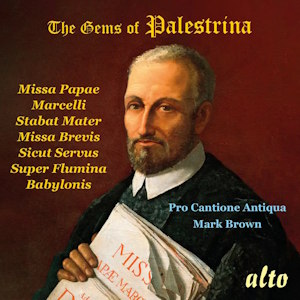
Giovanni Pierluigi di Palestrina (1525/6-1594)
Gems of Palestrina
Missa Papae Marcelli (1562)
Stabat Mater (c. 1584-1594)
Super flumina Babylonis (1581)
Sicut cervus (1581)
Missa Brevis (1570)
Pro Cantione Antiqua/ Mark Brown
rec. 1987/91, St Alban’s, Brooke Street, & St Jude’s, Hampstead Garden Suburb, London
No texts or translations
Alto ALC1707 [78]
Forget the corny title of this disc, which is more likely to deter than attract the listeners for whom it is intended. This is an admirable selection of works by Palestrina for the newcomer to his music. Or rather it would be an admirable selection if it contained texts and translations. You cannot nowadays assume that people know the words of the Mass and the Stabat Mater in Latin and English, though fortunately they are easily found on line. As for the words of the two motets, I shall provide them when I get to them.
The Mass of Pope Marcellus was named after Pope Marcellus II who reigned for only three weeks in 1555. Palestrina probably wrote the work in 1562 but may have had in mind an admonition from Pope Marcellus that ‘everything should be both heard and understood properly.’ The Council of Trent was in session at the time and there was some discussion of the appropriateness of polyphonic music in worship. From this a legend arose that there had been a move to ban it, but that this Mass of Palestrina convinced doubters that polyphony was after all acceptable. This legend was frequently repeated in history books but there is no basis for it. The fact is, however, that this mass is composed in a deliberately simplified style, without the complex overlapping of parts of many sixteenth century masses. It is easy to follow the text and this, apart from its excellence as music, has made it one of the most popular of Palestrina’s works.
The Stabat Mater is a thirteenth century hymn probably by the Franciscan friar Jacopone da Todi. It presents the suffering of the Virgin Mary as she stands at the foot of the Cross on which Jesus is dying. It was sung in the Sistine chapel after the Mass on Palm Sunday. However, it was not formally incorporated into the liturgy until 1727, when it became used in the Mass and Office of the Seven Sorrows of the Virgin Mary, observed on the Friday after Passion Sunday. Palestrina never published this work. He probably wrote it towards the end of his life, and it was incorporated into the Sistine chapel choir books around 1590. Palestrina’s setting is of grave beauty and, like the Missa Papae Marcelli, is easily followed.
The two motets here come from a 1581 collection and are among Palestrina’s most beautiful. The words of each are taken from the Psalms. Those of Super flumina Babylonis are from Psalm 136 in the Latin Vulgate, which is Psalm 137 in English Bibles and Prayer books:
Super flumina Babylonis, illic sedimus et flevimus, dum recordaremur tui, Sion.
In salicibus in medio eius suspendimus organa nostra.
By the waters of Babylon we sat down and wept: when we remembered thee, O Sion.
As for our harps, we hanged them up: on the trees that are therein.
The words of Sicut cervus desiderat are from Psalm 41 in the Vulgate, 42 in English books:
Sicut cervus desiderat ad fontes aquarum, ita desiderat anima mea ad te, Deus.
Sitivit anima mea ad Deum vivum: quando veniam et apparebo ante faciem Dei mei?
Fuerunt mihi lacrimae meae panes die et nocte, dum dicitur mihi per singulos dies: Ubi est Deus tuus?
Like as the hart desireth the water-brooks: so longeth my soul after thee, O God.
My soul is athirst for God, yea even for the living God: when shall I come to appear before the presence of God?
My tears have been my meat day and night: while they daily say unto me, Where is now thy God?
The Missa Brevis was published in 1570. Its title is misleading, as a missa brevis normally means either a short mass or one which omits some of the usual six sections of the Ordinary. However, this one is not particularly short and does not omit any of the text. It is an immediately attractive work, with some recurring themes, particularly a descending minor third following by a rising scale.
Pro cantione antiqua was an early music choral group which was active from 1968 to around 2000. They were basically an all-male group, as they are on this disc, where there are three counter-tenors, four tenors and five basses. They prepared their performances and recordings carefully and recorded for several labels. This disc has been skilfully remastered and sounds superb. The brief notes are good but there are no texts.
Stephen Barber
Buying this recording via a link below generates revenue for MWI, which helps the site remain free



















